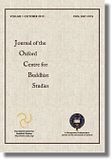JOCBS - 2011
JOCBS
Journal of the Oxford Centre for Buddhist Studies / Oxford Centre for Buddhist Studies. - Vol. 1 (2011). - Oxford : Oxford centre for Buddhist studies, 2011.
URL: http://www.ocbs.org/journal
Abstract: The present article begins by surveying the role of the ancient Indian god Brahmā in the early Buddhist discourses as exemplifying a tendency referred to in academic research as “inclusivism”. A prominent instance of this tendency can be found in the Ariyapariyesanā-sutta of the Pāli canon, which reports that Brahmā intervened to persuade the recently awakened Buddha to teach. This episode is absent from a Madhyama-āgama parallel to the Ariyapariyesanā-sutta, of which I provide a partial translation. The translation is followed by a brief evaluation of this difference between the two parallel records of the events surrounding the Buddha's awakening.
Abstract: This article highlights the growing role of laity in 20th century Chinese Buddhism. Like other Buddhist traditions in Asia, Chinese Buddhists were affected by the changes brought about by modernization. While lay Buddhists have played an important role throughout Chinese Buddhist history, during the modern period they assumed prerogatives that had been traditionally limited to monastics. The article explores three exemplary cases: a Tantric priest (Wáng Hóngyuàn), a scholar (Oūyáng Jìngwú) and a political leader (Zhào Púchū). The article examines the reaction of the Saṅgha to these lay Buddhists and their lasting impact on Modern Buddhism in China.
Abstract: This article first examines the textual structure of the Pāli Devatā and Devaputta Saṃyuttas in conjunction with two other versions preserved in Chinese translation in a collection entitled 諸天相應 Zhutian Xiangying in Taishō 2, nos. 99 and 100. Then it compares the main teachings contained in the three versions.
Abstract: Possible Hints of an Unknown Pāṇinian Commentary in Buddhaghosa’s Grammatical Arguments.
Abstract: A piece of Buddhist iconography which is widely found throughout mainland Southeast Asia is the Earth deity wringing out her hair to drown Māra and his army at the time of the Buddha’s enlightenment. This feature of the enlightenment story, however, is not found in the Tipiṭaka. The author offers an interpretation of the iconography as an allegorical visualization of the Buddha’s way to attain enlightenment.
Abstract: This essay tries to describe the influence of the Bhikkhus in Sinhala politics as demonstrated by the ideology, work and life of the Ven. Walpola Rahul-perhaps the most influential scholar monk in the modern Sangha of Sri Lanka. The attempt is to show how the Maha Sangha became the key actors in the continuum of an ideology of Sinhala ethnicity, their ownership of the island and duty to protect Sinhala Buddhist culture. Rahula’s contribution has created a new brand of Sangha who are committed to a different political path to redefine Sinhala Buddhism and modern Sri Lanka.
Abstract: The Sambhūmitta Pālā Kīrtan is a Bangladeshi devotional song based on an apocryphal life story of the Buddha originating in Thailand. Its style is that of the devotional songs more commonly associated with Vaiṣṇavism. This format is so popular in Bengal that it has become part of all religious traditions. The Buddhist tradition of Bangladesh is connected to those of Southeast Asia and the style of this song reflects a regional taste rather than an historical link to Indian Buddhism.
Abstract: he Sŏkka Yŏrae haengjŏk song (Ode on the acts of the Tathāgata Śākyamuni) was written by the Korean Ch’ŏnt’ae (Ch. Tiantai) monk Mugi in 1328. It is a biography of the Buddha in verse form, which in character somewhat resembles a seventh-century biography by the Chinese official Wang Bo. Both are based on Chinese renditions of the Buddha’s life story, but while Wang’s work is a terse adaptation tailored to the tastes of a literati audience, in Mugi’s work the terse verse format functions as a framework to contain extensive commentaries. The commentaries discuss Tiantai doctrinal points as well as issues that confronted both lay and monastic practitioners of the time. Mugi’s foremost concern seems to have been to use the life of the Buddha as an inspiration to counter lax interpretations of the precepts among his fellow monks and inspire them to have more respect for lay donors.

